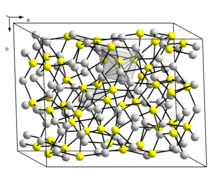Copper(I) sulfide (original) (raw)
From Wikipedia, the free encyclopedia
Copper(I) sulfide
 |
|
|---|---|
| Names | |
| IUPAC name Copper(I) sulfide | |
| Other namesCuprous sulfideChalcociteCopper glance | |
| Identifiers | |
| CAS Number | 22205-45-4  Y Y |
| 3D model (JSmol) | Interactive image |
| ChEBI | CHEBI:51114  Y Y |
| ChemSpider | 8305611  Y Y |
| ECHA InfoCard | 100.040.751 |
| PubChem CID | 62755 |
| RTECS number | GL8910000 |
| UNII | 349M3C1RS1  Y Y |
| CompTox Dashboard (EPA) | DTXSID0041804 |
InChI InChI=1S/2Cu.S/q2*+1;-2  YKey: AQMRBJNRFUQADD-UHFFFAOYSA-N YKey: AQMRBJNRFUQADD-UHFFFAOYSA-N  YInChI=1/2Cu.S/q2*+1;-2Key: AQMRBJNRFUQADD-UHFFFAOYAN YInChI=1/2Cu.S/q2*+1;-2Key: AQMRBJNRFUQADD-UHFFFAOYAN |
|
| SMILES [Cu+].[Cu+].[S-2] | |
| Properties | |
| Chemical formula | Cu2S |
| Molar mass | 159.16 g/mol |
| Density | 5.6 g/cm3 [1] |
| Melting point | 1,130 °C (2,070 °F; 1,400 K)[2] |
| Solubility in water | insoluble |
| Solubility | slightly soluble in HCl; soluble in NH4OH; dissolves in KCN; decomposes in HNO3, H2SO4 |
| Hazards | |
| Flash point | Nonflammable |
| NIOSH (US health exposure limits): | |
| PEL (Permissible) | TWA 1 mg/m3 (as Cu)[3] |
| REL (Recommended) | TWA 1 mg/m3 (as Cu)[3] |
| IDLH (Immediate danger) | TWA 100 mg/m3 (as Cu)[3] |
| Related compounds | |
| Other anions | Copper(I) oxideCopper(I) selenide |
| Other cations | Nickel(II) sulfideCopper(II) sulfideZinc sulfide |
Except where otherwise noted, data are given for materials in their standard state (at 25 °C [77 °F], 100 kPa).  Y verify (what is Y verify (what is  Y Y N ?) Infobox references N ?) Infobox references |
Chemical compound
Copper(I) sulfide is a copper sulfide, a chemical compound of copper and sulfur. It has the chemical compound Cu2S. It is found in nature as the mineral chalcocite. It has a narrow range of stoichiometry ranging from Cu1.997S to Cu2.000S.[4] Samples are typically black.
Preparation and reactions
[edit]
Cu2S can be prepared by treating copper with sulfur or H2S.[2] The rate depends on the particle size and temperature.[5]Cu2S reacts with oxygen to form SO2:[6]
2 Cu2S + 3 O2 → 2 Cu2O + 2 SO2
The production of copper from chalcocite is a typical process in extracting the metal from ores. Usually, the conversion involves roasting, to give Cu2O and sulfur dioxide:[6]
Cu2S + O2 → 2 Cu + SO2
Cuprous oxide readily converts to copper metal upon heating.
Crystals of chalcocite (mineral form of Cu2S).
Two forms (a dimorphism) of Cu2S are known. The so-called low temperature monoclinic form ("low-chalcocite") has a complex structure with 96 copper atoms in the unit cell.[7] The hexagonal form, stable above 104 °C,[8] has 24 crystallographically distinct Cu atoms. Its structure has been described as approximating to a hexagonal close packed array of sulfur atoms with Cu atoms in planar 3 coordination. This structure was initially assigned an orthorhombic cell due to the twinning of the sample crystal.
As illustrated by the mineral djurleite, a cuprous sulfide is also known. With the approximate formula Cu1.96S, this material is non-stoichiometric (range Cu1.934S-Cu1.965S) and has a monoclinic structure with 248 copper and 128 sulfur atoms in the unit cell.[7] Cu2S and Cu1.96S are similar in appearance and hard to distinguish one from another.[9]
The electrical resistivity increases abruptly at the phase transition point around 104 °C, with the precise temperature depending on the stoichiometry.[10][11]
- Copper sulfide for an overview of all copper sulfide phases
- Copper monosulfide, CuS
- Chalcocite
- Djurleite
- LK-99 - compound evaluated in 2023 for possible superconductivity
- ^ Patnaik, Pradyot (2002). Handbook of Inorganic Chemicals. McGraw-Hill, ISBN 0-07-049439-8
- ^ a b Greenwood, Norman N.; Earnshaw, Alan (1984). Chemistry of the Elements. Oxford: Pergamon Press. p. 1373. ISBN 978-0-08-022057-4.
- ^ a b c NIOSH Pocket Guide to Chemical Hazards. "#0150". National Institute for Occupational Safety and Health (NIOSH).
- ^ Potter, R. W. (1977). "An electrochemical investigation of the system copper-sulfur". Economic Geology. 72 (8): 1524–1542. Bibcode:1977EcGeo..72.1524P. doi:10.2113/gsecongeo.72.8.1524.
- ^ Blachnik R., Müller A. (2000). "The formation of Cu2S from the elements I. Copper used in form of powders". Thermochimica Acta. 361: 31. doi:10.1016/S0040-6031(00)00545-1.
- ^ a b Wiberg, Egon and Holleman, Arnold Frederick (2001) Inorganic Chemistry, Elsevier ISBN 0-12-352651-5
- ^ a b Evans, H. T. (1979). "Djurleite (Cu1.94S) and Low Chalcocite (Cu2S): New Crystal Structure Studies". Science. 203 (4378): 356–8. Bibcode:1979Sci...203..356E. doi:10.1126/science.203.4378.356. PMID 17772445. S2CID 6132717.
- ^ Wells A.F. (1984) Structural Inorganic Chemistry, 5th ed., Oxford Science Publications, ISBN 0-19-855370-6
- ^ Evans H.T. (1981). "Copper coordination in low chalcocite and djurleite and other copper-rich sulfides" (PDF). American Mineralogist. 66 (7–8): 807–818.
- ^ Garisto, Dan (2023-08-16). "LK-99 isn't a superconductor — how science sleuths solved the mystery". Nature. 620 (7975): 705–706. Bibcode:2023Natur.620..705G. doi:10.1038/d41586-023-02585-7. PMID 37587284. S2CID 260955242.
- ^ Jain, Prashant K. "Phase transition of copper (I) sulfide and its implication for purported superconductivity of LK-99." arXiv preprint arXiv:2308.05222 (2023).
